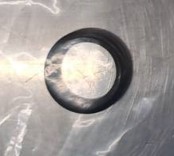
O-ring is one of the most common sealing materials and can be seen in various industrial fields. O-ring uses more than dozens of materials so that it can be used safely in complex environments such as high temperature, acidity, and high pressure to avoid leakage that may cause equipment failure or even personal injury.
In addition to the O-ring aging, damage, elastic fatigue and loss of sealing effect over time, there is another problem that is easily overlooked, which is that its internal impurity elements may be gradually released, especially in In the semiconductor industry, the release of any impurity elements in the machine is a major problem, affecting product quality and yield. However, O-rings have become one of the most overlooked sources of pollution due to their small size. However, there may be more than dozens of O-rings used in one machine, and the risks cannot be underestimated. Therefore, the safest and most secure way is to analyze the O-ring to ensure its quality before installing and using it.
The main purpose of impurity testing for O-ring is to confirm whether there are impurities in the O-ring material that may have a negative impact on the production process or product quality, especially in high-demand industries such as semiconductors, pharmaceuticals, etc. . Impurity detection has the following important benefits:
1. Avoid contaminating products
Impurity elements (such as metals, volatile organic compounds, etc.) in O-ring materials may be gradually released during equipment operation, contaminating the manufacturing environment or products. In the semiconductor manufacturing process, trace amounts of impurities may affect the electrical performance and yield of the product. Impurity testing ensures that no harmful elements are released from the O-ring to avoid product contamination.
2. Improve process stability
Semiconductor equipment has extremely high requirements for purity during the manufacturing process. The released impurities may cause abnormal operation of the machine or equipment failure, affecting production efficiency. By detecting the impurity content of the O-ring, such risks can be reduced and the stability of the overall process can be improved.
3. Ensure equipment reliability
Impurities in the O-ring material may react with chemicals or gases inside the machine, causing corrosion or wear and affecting the life of the equipment. Testing can detect these potential problems in advance and ensure the reliability of the equipment during use.
4. Comply with industry standards
Many high-tech industries have strict material purity requirements. Impurity testing can ensure that O-rings meet relevant standards and avoid substandard materials from affecting product and brand reputation.
5. Preventive quality control
Conducting impurity testing before installation can be used as part of quality assurance to reduce the risk of future equipment or product problems, reduce downtime maintenance costs and potential quality losses.
To detect impurities released from O-ring, the instrument with the best detection capability and the ability to detect multiple elements at the same time is ICP-MS. Appropriate pre-processing measures are required before O-ring analysis. The following will introduce three pre-processing methods:
1. Surface impurity analysis: Only micro-pollutants on the O-ring surface are analyzed.
2. Dissolution analysis: Soak the O-ring in chemicals. The impurities inside the O-ring will gradually dissolve over time. Finally, analyze the soaking liquid to obtain the dissolution amount and dissolution rate.
3. Microwave digestion analysis: Take O-ring for microwave digestion operation, dissolve the sample in the digestion liquid, and obtain the impurity content of O-ring.
The operation process can be divided into two parts:
1. Pre-processing: Use PFA clips to hold the O-ring in the O-ring pre-processing part to avoid secondary contamination.
Then select different pre-treatment methods according to the purpose of analysis to obtain the solution to be tested;
2. ICP-MS analysis: Perform ICP-MS analysis on the processed solution to be tested according to standard procedures
Finally, a complete data report can be produced for customer reference; the following is an example of dissolution analysis:

| Element |  |
 |
| Sodium | 24.2 | 3.5 |
| Magnesium | 6385.9 | 2.6 |
| Aluminum | 17.1 | 9.5 |
| Potassium | 38.5 | 2.4 |
| Calcium | 3537.2 | 73.2 |
| Iron | 32.78 | 22.7 |
| Zinc | 16.19 | 660.9 |
| Barium | 3.82 | 4.97 |
Shangwei Technology can provide customers with more than 40 element testing results to help customers obtain more complete information; if you have needs for metal element testing and analysis of raw materials, please feel free to contact us!
 Inquiry mailbox x
Inquiry mailbox x